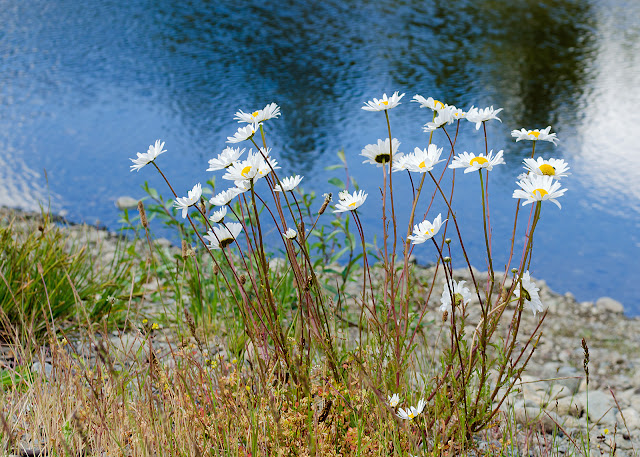(I tasted my first huckleberries of the year Monday. Small and seedy, and not at all sweet yet. The thimbleberries are pale pink and hard; the blackberries are green. They'll all be ready in a few weeks.)
These wildflowers were blooming beside the lakes and rivers across the top of the island last weekend.
 |
| Red columbine, Aquilegia formosa. On the rocks by a waterfall. 49.72992, -126.09537. Hummingbirds love these. |
 |
| Unidentified flowers, growing on rock face. |
Does anyone recognize these? There were many of them, all growing out of cracks in the rocks above our heads, none within reach.
UPDATE: Found it! Silverleaf luina, Luina hypoleuca.
 |
| Oxeye daisies, Leucanthemum vulgare, Strathcona Lodge, Upper Campbell Lake. |
"The young leaves of oxeye daisy are edible and very sweet." (Plants of Coastal BC)
I didn't know that.
 |
| Fireweed, Epiloblum angustifolium, Strathcona Lodge. Also edible. |
 |
| Hardhack, Spiraea douglasii, just coming into bloom beside a swamp. They love wet feet. |
 |
| Pacific ninebark, Physocarpus capitatus, beside Crest Lake,49.84377, -125.91223. |
 |
| Self-heal, Prunella vulgaris spp. lanceolata. Gravelled pathway beside highway near the columbine. |
These self-heal flowers were like the ones in my lawn, but about twice their size, and more intensely purple. I wondered about this, and looked them up in E-Flora.
Two subspecies occur in BC:
1. Principal stem leaves egg-shaped to oblong (averaging half as broad as long), broadly wedge-shaped or rounded at base.................... ssp. vulgaris
1. Principal stem leaves lanceolate to egg-shaped (averaging one-third as broad as long), narrowly wedge- shaped to abruptly pointed at base.................. ssp. lanceolata
The leaves on this plant are long and narrow, and pointed at the base, so this would be subspecies lanceolata, and is a native plant. The other subspecies (the one in my lawn) is an import from Eurasia.

No comments:
Post a Comment
I'm having to moderate all comments because Blogger seems to have a problem notifying me. Sorry about that. I will review them several times daily, though, until this issue is fixed.
Also, I have word verification on, because I found out that not only do I get spam without it, but it gets passed on to anyone commenting in that thread. Not cool!